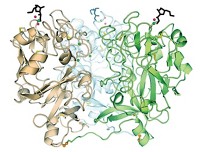Advertisement
Grab your lab coat. Let's get started
Welcome!
Welcome!
Create an account below to get 6 C&EN articles per month, receive newsletters and more - all free.
It seems this is your first time logging in online. Please enter the following information to continue.
As an ACS member you automatically get access to this site. All we need is few more details to create your reading experience.
Not you? Sign in with a different account.
Not you? Sign in with a different account.
ERROR 1
ERROR 1
ERROR 2
ERROR 2
ERROR 2
ERROR 2
ERROR 2
Password and Confirm password must match.
If you have an ACS member number, please enter it here so we can link this account to your membership. (optional)
ERROR 2
ACS values your privacy. By submitting your information, you are gaining access to C&EN and subscribing to our weekly newsletter. We use the information you provide to make your reading experience better, and we will never sell your data to third party members.
Biological Chemistry
Fast Enzyme Has Fatty Ancestry
Chalcone isomerase is found to have evolved from noncatalytic fatty acid-binding proteins
by Stu Borman
May 28, 2012
| A version of this story appeared in
Volume 90, Issue 22
A study of the origin of one of nature’s most efficient enzymes could have implications for better understanding and influencing the way plants produce oils (Nature, DOI: 10.1038/nature11009). Chalcone isomerase (CHI) is an nearly perfect enzyme because it catalyzes flavonoid production almost instantaneously in the presence of chalcone substrate. The enzyme’s evolutionary provenance now suggests CHI is related to protiens that manage fatty acid metabolism. Eve Syrkin Wurtele of Iowa State University, Joseph P. Noel of the Salk Institute for Biological Studies, and coworkers have carried out gene sequence comparison and structural studies that show noncatalytic fatty-acid-binding proteins (FABPs) to be CHI’s evolutionary predecessors. In the study, the group obtained crystal structures of two FABPs and compared them with that of CHI, which Noel’s group obtained over a decade ago. The structures revealed that FABPs bind fatty acids in a pocket similar to the one CHI uses to bind chalcone. According to Noel, “the work has implications for modulating plant fatty acid profiles,” which impact the use of plants as sources of food oils, biorenewable chemicals, and biofuels.





Join the conversation
Contact the reporter
Submit a Letter to the Editor for publication
Engage with us on Twitter